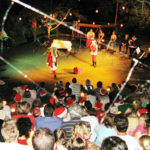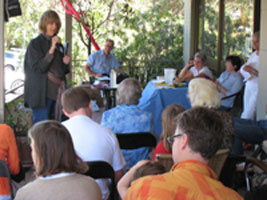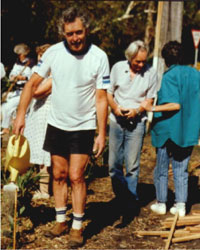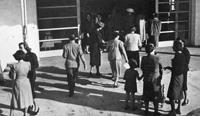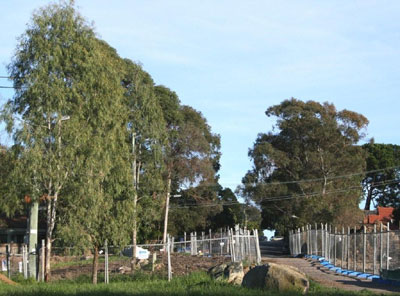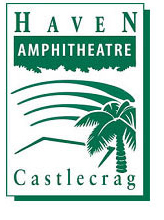
Summerhaze at The Haven
‘Summerhaze at The Haven’ scheduled for 1 December promised to bring six youth bands together sharing a love of roots, blues and funk. All had donated their talents to registered charity ‘The Beats That Give Back’ to fund a rainforest project.
Unfortunately rain cancelled the full show at the last minute.
Nevertheless, in The Haven tradition, some 80 young people risked the showers and rocked to the music of ‘The Pachamamas’ with local musos Scott Wilson and Tim Charody, together with the visiting Melbourne band ‘The Landlords’ (both worth google-ing). With the barbeque sizzling, the bluesy rhythms soon had the dancers on the stage. When the organisers announced that costs had not been covered, the revellers dipped again into their wallets in a generous manner.
Bruce Wilson
…and just a drop of Cab Suave……
PATRICIA O’CALLAHAN and THE GRAHAM JESSE QUARTET in cabaret
The Haven Committee was hoping for a balmy Sydney summer evening for our cabaret on 8 December. All the catered tables were booked, the seating on the Griffin tiers (normal stone seating) was almost full and Michael from the Bai Yok restaurant had created a special dinner for the evening. One of Sydney’s best musicians and Haven Committee member Graham Jesse had brought together his superb jazz quartet to accompany the world class cabaret singer Patricia O’Callaghan who had agreed to perform for us, because she loves the venue. We were set for one of the best nights of outdoor entertainment ever!
Unfortunately, the rain had been with us all week and continued into the morning and there was grey fuzzy cloud above—the forecast was ominous, the setup arduous and by midday the difficult decision had to be made to play safe and retreat to the wet weather venue at Northbridge Men’s Bowling Club.
Although the ambience was not quite the same, it was very pleasant and the performances were fantastic. Graham Jesse and his group opened with some superbly executed jazz classics and the scene was set for Patricia O’Callaghan. We were immediately enthralled by Patricia’s skill and the power and joy of her performance with compositions from the likes of fellow Canadian Randy Newman, Kurt Weill and Edith Piaf with songs such as Cry me a River, Try to Remember, and Leonard Cohen’s Hallelujah. A very full programme of rich sounds and eclectic music continued to captivate us for the rest of the evening. Great music, delicious food and a grand time was had by all.
The Haven looks forward to staging more cabarets in 2008 and Patricia has promised to go again with us at the Amphitheatre in 2009. And what of the evening weather on 8 December? The grey fuzzy cloud slowly wandered off and we were left with a mild Sydney Summer evening!
Christmas Carols 2007 was a huge success, with our biggest crowd ever; there was not a spare rock or piece of earth to be found! Our thanks go to Marlene Vaughn and her musical ensemble—we were particularly privileged to have Julia de Plater join us this year as pianist. The committee was deeply touched by the generosity shown by our community towards the orphaned children in Cambodia. Our first ‘Haven Giving Tree’ was laden with a variety of new, superior quality clothing as well as colourful tools to draw and write with. Marion Mahony Griffin (the Haven’s benefactor) would have been proud! The gifts are being personally delivered, travelling as excess baggage with the mother of the young Australian woman, Tara Winkler, who is voluntarily running the Orphanage. We will let you know how they were received in the next Crag. The Committee offers a big thank you to all who contributed.
Lindy Batterham
The Wind in the Willows As you can see from our poster on page 12, our major autumn production at The Haven will be a new adaptation of the ever-popular Kenneth Grahame classic. You can meet all the loveable riverbank animals and follow their irrepressible adventures outdoors in the idyllic bush setting of The Haven Amphitheatre in Castlecrag!
The Wind in the Willows is the second co-production between RAW-EM Theatre Co. and The Haven Amphitheatre Committee. Julie McKay, the producer behind RAW-EM, is confident that this production will build on RAW-EM’s reputation for delivering a great night’s entertainment which has had audiences either coming back a second time or spreading good ‘word of mouth’ to family and friends.
This live performance would be ideal way for HSC English students to study Wind in the Willows as a supplementary text for The Journey area of study. A pamphlet will be available on how this production explores physical, imaginative and inner journeys.
Howard Rubie
ARCHIVIST needed! The Haven Amphitheatre is looking for someone who could help create more order with its records. A little time is all that’s needed. Please ring Lindy Batterham 9958 2127 if you can offer your services in any way. www.thehaven.biz
